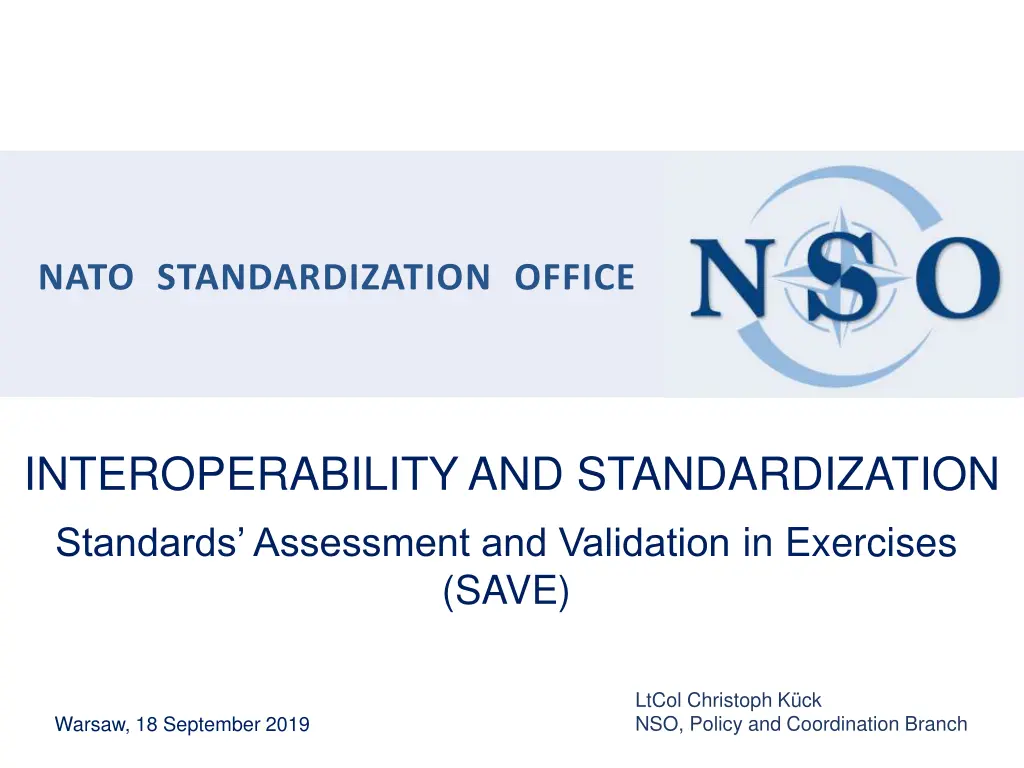
NATO Standardization Office: Standards Assessment and Validation in Exercises
Explore the NATO Standardization Office's approach to assessing and validating standards, with a focus on interoperability and implementation in exercises. Learn about the holistic principles, feedback mechanisms, and challenges faced in standards relevance and implementation.
Download Presentation

Please find below an Image/Link to download the presentation.
The content on the website is provided AS IS for your information and personal use only. It may not be sold, licensed, or shared on other websites without obtaining consent from the author. If you encounter any issues during the download, it is possible that the publisher has removed the file from their server.
You are allowed to download the files provided on this website for personal or commercial use, subject to the condition that they are used lawfully. All files are the property of their respective owners.
The content on the website is provided AS IS for your information and personal use only. It may not be sold, licensed, or shared on other websites without obtaining consent from the author.
E N D
Presentation Transcript
NATO STANDARDIZATION OFFICE INTEROPERABILITY AND STANDARDIZATION Standards Assessment and Validation in Exercises (SAVE) LtCol Christoph K ck NSO, Policy and Coordination Branch Warsaw, 18 September 2019
Agenda 1. Holistic Approach to Standardization Validation of Standards Relevance and Level of Implementation 2. Standards Assessment and Validation in Exercises (SAVE) 3.
Agenda 1. Holistic Approach to Standardization Validation of Standards Relevance and Level of Implementation 2. 3. Standards Assessment and Validation in Exercises
Principle for NATO Standardization: Holistic / Systemic Approach Definition/ Identification of Requirements Effective Feedback Loop Development of Standardization Solutions Validation of Standard(s) (LL Process) Implementation of Standard(s) 4
Agenda 1. Holistic Approach to Standardization Validation of Standards Relevance and Level of Implementation 2. 3. Standard Assessment and Validation in Exercises
Validation of Standards Relevance and Implementation Challenge: How to solicit information on STANAG implementation and relevance? Mechanisms: Implementation reporting by nations NDPP (Step 5): Feedback from nations on STANAG implementation Feedback from operations Feedback from NATO exercises / evaluation 6
STANAGs Validation Feedback Loop Analysis Nations Lessons Identified NATO ACT ACO LTRP STANDARDISATION PROCESS NSO SCs NSO NDPP Improving INTEROPERABILITY .. TAs DTAs WGs Observations Requirements TRAINING & EXERCISES ACT/ACO NATO EVALUATIONS ACO OPERATIONS ACO eNRF, 7
Agenda 1. Holistic Approach to Standardization Validation of Standards Relevance and Level of Implementation 2. Standards Assessment and Validation in Exercises (SAVE) 3.
NATO Standards Assessment and Validation in Exercises (SAVE) Background: NATO needs standards to be current, relevant and valid Exercises and evaluations (e.g. NRF preparation events) opportunity for objective feedback on standards as key for interoperability SAVE requires primarily national experts 9
SAVE Framework Steps (1) 1. TAs & DTAs identify standards to be assessed/validated employing expertise in WG s, Panels, Syndicates, etc. employing Alliance & TA s established priorities 2. TAs & DTAs match selected standards to upcoming exercises (2-3 years before exercise dates) 3. TAs/DTAs identify task group, team or experts to conduct SAVE activities during the selected exercise 10
SAVE Framework Steps (2) 4. Team/Expert participates in Exercise Preparation Process selected exercise (EXSPEC Conferences, CPT, IPC, MPC, FCC) to ensure SAVE activities are smoothly integrated 5. Team/Expert develops SAVE plan for the given exercise and standard(s) 6. Team/Expert conducts the assessment/validation in exercise 7. Team/Expert delivers report on findings, through WG channels, to the TA/DTA 11
Long Term Exercise Planning 1. MTEP (Military Training and Exercise Programme) SACT leads MTEP development, management & execution Published annually, covers all collective training & exercises for 5 years Detailed info on activities scheduled for the first 2 years 2. SAGE (SACEUR s Annual Guidance for ETEE) Strategic level guidance & priorities for NATO E&T for 5 years Links NATO E&T activities to strategic objectives Indicates why and for what NATO is preparing forces 3. Annual Training Synchronization Conference 4. Evaluation Programming & Management Board 12
NATO Exercises Process - Main Events - M-14 EXSPEC Conference Initial Planning Conference Main Planning Conference Final Coordination Conference Operational Conduct (Exercise) M 13
NATO STANDARDIZATION OFFICE INTEROPERABILITY AND STANDARDIZATION Standards Assessment and Validation in Exercises (SAVE) LtCol Christoph K ck NSO, Policy and Coordination Branch Warsaw, 18 September 2019
